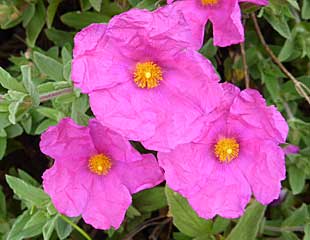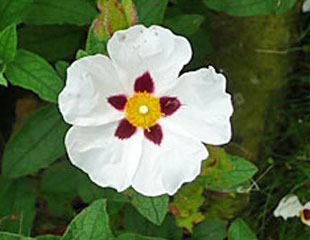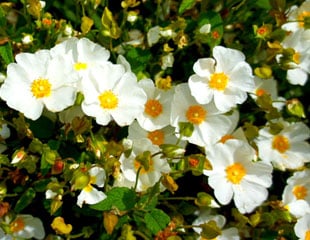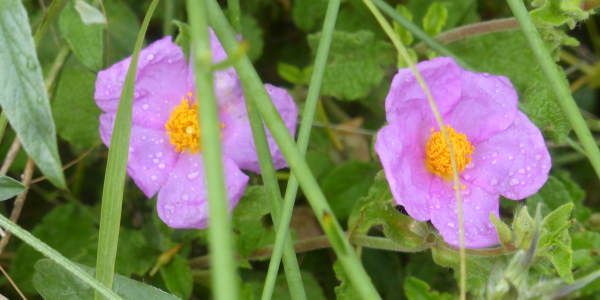


How to grow Cistus common name Rock Rose
Cistus is a small to medium-sized summer flowering evergreen shrub. It is also known as Rock or Sun Rose and its common names suggest the ideal growing conditions. Cistus is native to Mediterranean regions and they like dry and sunny conditions. Cistus is classified as H4 hardy, which is good down to - 15 so ** hardy in most parts of the country. Their Mediterranean roots mean they are only effectively hardy when grown in well drained, sunny conditions.
Cistus blooms in whites and pinks, as the images above show, almost papery in appearance. Cistus is a smaller shrub useful for the front of a border. Illustrated C. x Creticus left image, which grows up to 1m (**), and re C. x cyprius up to 1.5 m (**) and a view of the shrub overall in the right image.
If you have the right growing conditions, Cistus is a lovely shrub, especially mixed in with Mediterranean plants, such as Rosemary, Artemisia, Santolina, lavender Sage, including Russian Sage, which is a good drought resistant combination.
In less than ideal growing conditions, where the soil is wetter, and conditions colder, Cistus will be a short-lived shrub.
Not to be confused with Cytisus, common name broom, a deciduous shrub which flowers in late spring early summer.
Where to plant Cistus
Plant Cistus in well drained soil in full sun and sheltered from cold winds. Cistus will grow in thin soil and is drought tolerant. In fact, if soil or the growing conditions are too wet, Cistus is unlikely to thrive. The main consideration to get Cistus to survive and flower well is soil which does not hold wet, especially over winter and lots of sun.
Not all Cistus are not fully hardy and need dry warm sunny conditions to thrive. Whilst the downside is that they are not fully hardy, they are deer resistant, tolerant of salt-laden winds and drought resistant. Cistus prefers Alkaline soil but will survive on acid soil providing the other conditions are good. Most grow to around 1m and are generally hardy to H3/H4 but most important is good drainage, otherwise Cistus will not survive a winter well. Plant Cistus with space to grow into because Cistus does not respond well to pruning, especially hard pruning.
Which Cistus are the most hardy?
If your garden is exposed or tending to be more cold, you may want to look at the more hardy of the Cistus family which are C. laurifolius C. salviifolius and hybrids such as C. x corbariensis, C. x purpureus and C. 'Silver Pink'. Cistus can survive lower temperatures provided it is not too wet or too severe a winter. Cistus are short-lived shrubs in any event, and if they get badly scorched by a severe frost they are best replaced. C. x corbariensis is noted to be the hardiest and has white flowers.
Cistus creticus growing wild in Crete

Cistus creticus, above as the name suggests, is native to Crete and is known as the Cretan Rock rose. It is just one of the many beautiful wild flowers in Crete and I have been lucky enough to see and photograph growing in its native habitat, and shown here on Pinterest.
It is always exciting to see plants you know growing wild and Crete has many wild flowers to enjoy, (which makes it a great holiday destination.)
When to prune Cistus?
The answer to this is only lightly. Cistus are evergreen, or semi-evergreen and flower well for most of the summer and look very attractive in the border. Young plants can be lightly trimmed, but with mature plants it is best not to prune too hard or prune into the old wood. Cistus are best pruned lightly after flowering to keep in shape.
In the right place, Cistus is entirely trouble free and will bloom freely. If the garden conditions are not good, Cistus x Dansereaui 'Decumbens' is well suited to growing in a tub provided it has good drainage. Mixing grit with the compost will help, and shelter from harsh frost and chilling winds.

I rate Cistus amber wheelbarrow. Although the shrubs need little attention once established, it is a case of "right plant right place" and it can be a problem finding the right place. Another reason to Cistus code amber is because if there is a cold winter, Cistus are susceptible and may not come back in the spring, or can look a bit of a mess with brown scorched leaves.
Cistus can be propagated by cuttings. Rooted the cutting in the summer and keep under glass for the winter to replace any plants killed over the winter.
Cistus are suitable for gardens by the sea-side, there are many more ideas on the Pinterest page and at gardening by the sea-side.
If Cistus is not the shrub for you, check out Summer flowering shrubs, Spring flowering shrubs and evergreen shrubs.
